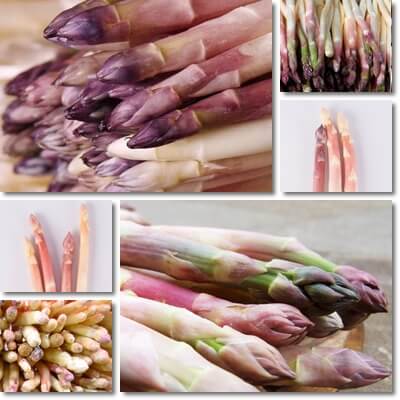What is pink asparagus? There’s really no such thing as pink asparagus, meaning this particular color variant of the vegetable is not officially recognized as a variety in its own right. What we commonly call ‘pink asparagus’ is actually low-grade white asparagus, that is substandard white asparagus that is not completely white. To produce white asparagus, green asparagus is grown covered up with soil so it doesn’t receive any sunlight. As a result, it doesn’t develop any pigment and stays white. But when the white stalks get exposed to some sunlight, they starts developing pigment, usually light pink, violet or purple.
Depending on how much of the stalk is exposed to sunlight and for how long, color coverage and pigmentation may differ from stalk to stalk. That is to say, pink asparagus can be entirely pink, half white and half pink, white with pink, violet, purple and even yellowish and greenish tips. What most people don’t know about growing the pink stalks is that soil pH has a big say in determining pigment and color intensity, which explains the surprising variation in pink asparagus appearance.

What does pink asparagus look like?
Spear-shaped, sturdy, elongated stalks with small, scale-like leaves that cluster at the top, forming a tight, pointed end. As for color, it’s possible to have pink asparagus that is entirely pink or pink-violet, or white with colorful tips, either one color, or more. It’s not unlikely to see pink, violet, purple, yellowish and greenish tips in otherwise unpigmented white asparagus. The compounds responsible for the popular pink color of the stalks are anthocyanins, and these produce an entire range of colors, from red to purple to blue and black. Anthocyanins are sensitive to soil pH and other factors which can at least partially explain the color range seen in what is supposed to be pink asparagus. So soil pH determines whether your pink asparagus will be pink or a reddish-violet or purple or yellowish or greenish.
For example, if the soil has an acidic pH, 6.5 and lower, then the stalks will likely turn out pink. If the soil pH is closer to neutral, then the stalks will likely turn out pink-violet. A more soil neutral pH, in the range of 6.6-7.2, gets you purplish stalks. Whereas a slightly alkaline soil pH, 7.2 and higher, will generate yellowish to greenish pigments in the stalks. But only the areas exposed to sunlight will develop pigment – the parts of asparagus grown underground or covered, stay white (because pink asparagus is actually a variant of white asparagus). If the entire stalk receives sunlight, then it will develop pigment all over. But if only the tips rise from underneath the soil, only they will develop pigment. Also see the benefits of white asparagus.
What does pink asparagus taste like?
Overall, pink asparagus tastes fairly similar to white asparagus. That is to say the peel can have a moderately to strong bitter taste – as a result, it needs to be removed prior to cooking along with the woody bottom ends. The flavor profile further includes mild earthy notes and faint sweet flavors. To counteract the bitterness, add an acidic ingredient during or after cooking (lemon or lime juice, other citrus juices, white, red or balsamic vinegar), or cook in plenty of butter or cream. Grilling, pan or oven roasting, stir-frying and boiling are all great options for cooking the stalks. For the best taste experience, choose young stalks – the younger the stalks, the less bitter and more palatable they are, not to mention tender. Green, purple and white varieties can all be cooked the same way and paired with the same ingredients (salt, pepper, butter, cream, Hollandaise sauce, cured, boiled or smoked ham, bacon, prosciutto and other cold meats, eggs, potatoes etc.).

Nutrition facts
There is virtually no nutritional information available on pink asparagus, in part because it’s not even considered a variety in its own right (at least not at the moment). However, some nutrition facts can be inferred from the nutritional profile of green asparagus, given that it is the same botanical species, grown in roughly the same conditions. This being said, pink asparagus is presumed to be a good source of B vitamins, B1, B2, B3, B5, B6 and B9, but also vitamins C and E and small amounts of vitamin K. Essential dietary minerals such as copper, iron, magnesium, manganese, phosphorus, potassium, selenium and zinc are also present, but their content is variable, determined by soil quality as the plant uptakes the minerals from the soil it’s grown in.
Pink asparagus further contains good amounts of dietary fiber, most of which resides in the peel (the peel can be eaten if the stalks are young and tender). It is a modest source of protein and carbohydrates, low in sugar, fat and calories. Anthocyanins account for the majority of antioxidants in the color variety, but other flavonoid antioxidants are also present in smaller amounts. The stalks with the least amount of pigment, that is those that are mostly white, are lowest in antioxidants. The stalks that have the most pigment, whether pink or violet or purple, have the most antioxidants. Also see the benefits of purple asparagus.
What are the benefits?
The benefits associated with a reasonable intake of pink asparagus are modest and may include:
- Source of the amino acid asparagine which is important for brain health and nervous system function.
- Good food for weight loss: low in calories (around 20 kcal per 100 g), but also sugar and fat to actively promote weight loss, and a good source of dietary fiber to promote satiety and curb hunger.
- Helps provide relief for constipation thanks to good amounts of dietary fiber (around 2 g of fiber per 100 g).
- Naturally low in sodium and a source of magnesium and potassium, pink asparagus is a good food to consider for a hypertension diet as it has diuretic effects and helps lower blood pressure numbers (however, anti-hypertensive effects are modest).
- Anthocyanins and other antioxidants scavenge free radicals and help prevent oxidative stress and related cell damage that could lead to the development of chronic disease.
- Potential benefits for the immune system from vitamin C, iron, copper, manganese and antioxidant anthocyanins which support the immune system function.
- Good food for skin and brain and nervous system health thanks to varied B vitamin content.
- Minor benefits for energy metabolism from B vitamins and iron.
- Potential benefits for pregnant women thanks to vitamin B9: studies show vitamin B9 helps with normal development of the brain and nervous system of the baby during pregnancy and prevents neural tube defects of the brain, spine and spinal cord.
- Anticancer properties: an animal study on white asparagus shows the methanolic extract of the variety reduces inflammation markers and activates apoptosis (programmed cell death) in a line of colon cancer cells.
Given that it is essentially a more colorful variant of white asparagus, pink asparagus holds anticancer properties as well.
What are the side effects?
- Bad-smelling urine. Eating pink asparagus can cause urine to smell bad. The odor is a result of naturally-occurring sulfur compounds that are eliminated through urine after the asparagus is digested. The bad urine odor is described as being sulfur, ammonia or medication-like. Not everyone picks it up though, so if you think eating asparagus doesn’t make your urine smell bad, it’s likely because you can’t smell it.
- Potential for allergic reactions. Like all foods, pink asparagus too has the potential to cause allergic reactions. An allergic reaction may cause itching, redness, swelling, respiratory system symptoms such as coughing, wheezing, swelling of the lips, tongue or throat, asthma and culminate with anaphylactic shock, which is a medical emergency. If you suspect or know for sure you are allergic to a food, avoid it in all forms and preparations.
